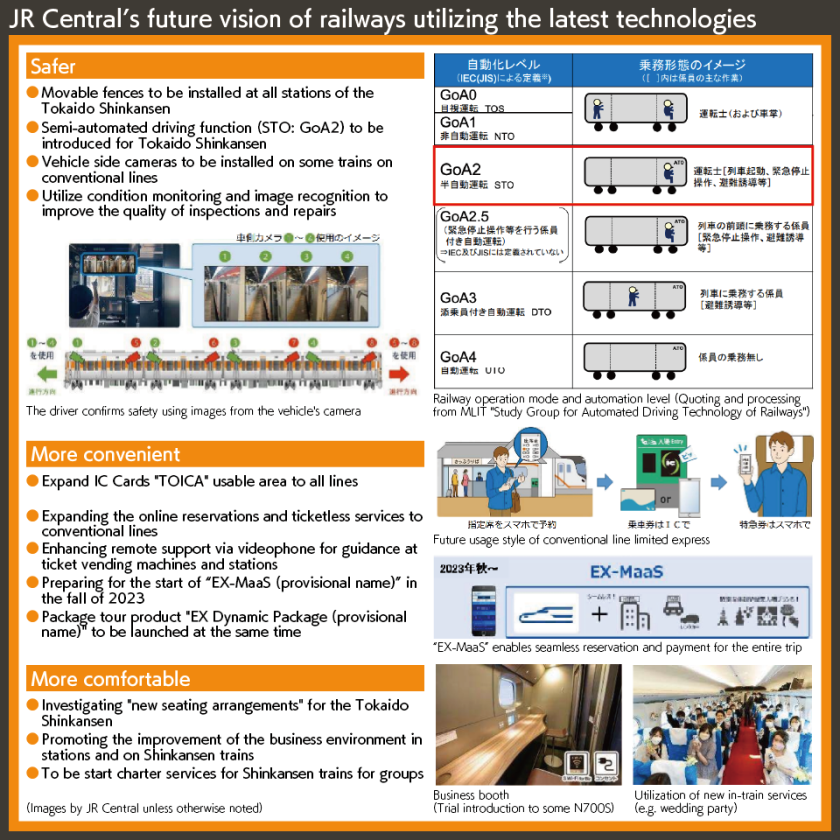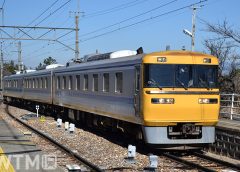JR Central presented a vision of the future of railways that utilize the latest technologies such as ICT, and disclosed various initiatives to improve safety, convenience, and comfort while improving efficiency.

Platform fences expanded to all Shinkansen stations
They are promoting “business reforms” to reduce regular costs by ¥80 billion on a stand-alone basis by building an efficient system over the next 10 to 15 years. In addition, they are aiming to reinforce their management strength by taking on the challenge of realizing “increase in earnings” through new ideas. As part of this initiative, they have begun to actively incorporate the latest technology and radically change the structure of transportation services. Major initiatives that utilize technologies such as “sensing,” “image recognition,” “transmission and analysis of big data,” “AI,” and “robots,” which have evolved significantly in recent years, were introduced as “future visions of railways.”
On the Tokaido Shinkansen, all stations will be equipped with movable fences to improve safety on platforms, and a semi-automated operation function (STO) will be introduced to support the work of drivers. The start-up operation will be performed manually by the driver, but speed control and stop operation while driving are automated. This semi-automated operation corresponds to the railway automation level “GoA2” specified by the Ministry of Land, Infrastructure, Transport and Tourism (MLIT) Japan, and there are examples of introduction in Japan such as Tokyo Metro (Marunouchi and Namboku Lines, etc.) and Metropolitan Intercity Railway Company (Tsukuba Express). In addition, the driver will be in charge of monitoring the safety on the platform and opening and closing the doors when arriving at and departing from the station, and the conductor will focus on on-board operations, such as supporting unfamiliar passengers and strengthening security through patrols.
As a safety initiative on conventional lines, some trains with three or more cars will have cameras installed on the sides of the cars so that the driver can check the safety with images. While considering measures such as using image recognition technology to detect things like being caught in the door or falling, they plans to introduce conductorless operation to trains with three or more cars. In addition, inspections and repairs that used to rely on manual labor and visual inspection will now incorporate diagnostics that make use of condition monitoring and image recognition, and systematization of result input will improve reliability and efficiency. Employees will engage in verification using big data analysis and will work to further improve the quality of inspections and repairs (See the figure below about JR Central’s “future visions of railways”).

Conventional express trains will also accept ticketless
As a measure to improve convenience, it was announced that the usage area of the transportation IC card “TOICA” will be gradually expanded to all lines within their jurisdiction. In addition, they will develop a service that allows people to reserve seats and purchase commuter passes using smartphones, etc., so that you can board not only the Shinkansen but also conventional lines without stopping at a station window. “EX-MaaS (provisional name)” will be launched in the fall of 2023 as a new service that makes it easier to go out for business trips and travel, and it will be possible to seamlessly make reservations and payments for Shinkansen, hotels and transportation at destinations. At the same time, the “EX Dynamic Package (provisional name)”, which allows you to freely combine Shinkansen, hotels and sightseeing plans, will be released at the same time. It is the first package product in Japan that allows you to change trains until just before boarding.
At stations, remote support will spread through the use of videophones. The introduction of “reserved seats ticket vending machines with remote support” and “concentrated passenger service system” will be expanded, and the number of stations where tickets can be purchased even in the early morning or late at night will increase. Station staff will mainly perform tasks that require face-to-face guidance, and staff assignments will be optimized according to the actual usage situation.
As high-value-added services that meet a variety of needs, they are considering the setting of “upper-class seats in Green Cars,” which allow passengers to spend their travel time more comfortably, and seats that further enhance the business environment. Details will be announced as soon as they are decided, but there is a possibility that a service similar to “Gran Class” provided mainly by JR East will also start on the Tokaido Shinkansen. In addition, like “EXPRESS WORK” and “Business Booth”, they will further enhance the provision of workspaces before and after riding. They will also offer a car charter service for groups that can hold events such as wedding parties on the Shinkansen, and propose new ways to use the Shinkansen.
Through these service reforms, JR Central commented, “In addition to responding to the future decline in the working population, we will efficiently provide safer, more convenient, and more comfortable services.”

 [JR Pass] Japan Takayama-Hokuriku Area Tourist Pass including the Hokuriku Shinkansen bullet trains and buses to Shirakawago (Delivery to Multiple Countries) (Ad by KKday)
[JR Pass] Japan Takayama-Hokuriku Area Tourist Pass including the Hokuriku Shinkansen bullet trains and buses to Shirakawago (Delivery to Multiple Countries) (Ad by KKday) [Japan] Shoryudo Highway Bus Pass | Get unlimited bus rides to Takayama, Kanazama, Toyama, and Nagoya areas (Ad by KKday)
[Japan] Shoryudo Highway Bus Pass | Get unlimited bus rides to Takayama, Kanazama, Toyama, and Nagoya areas (Ad by KKday)



